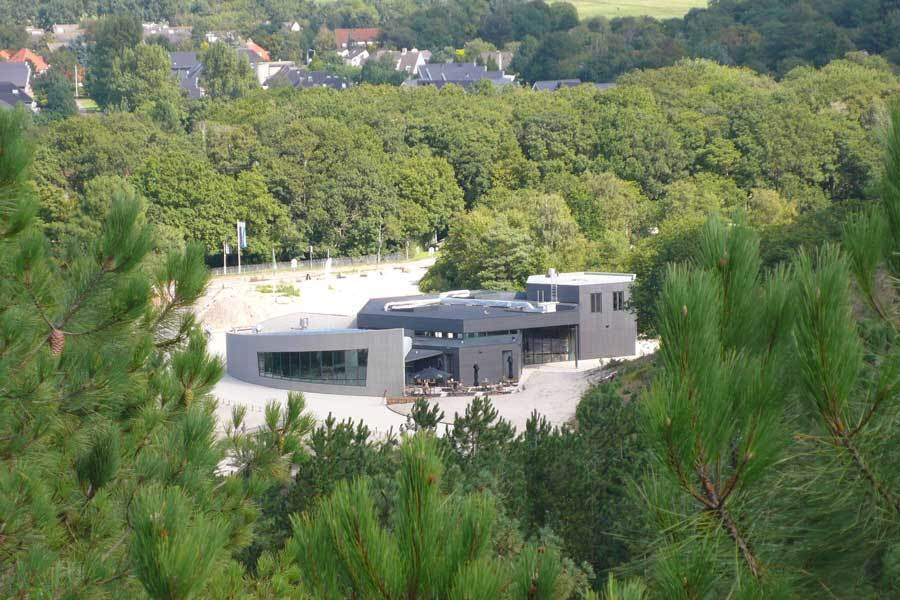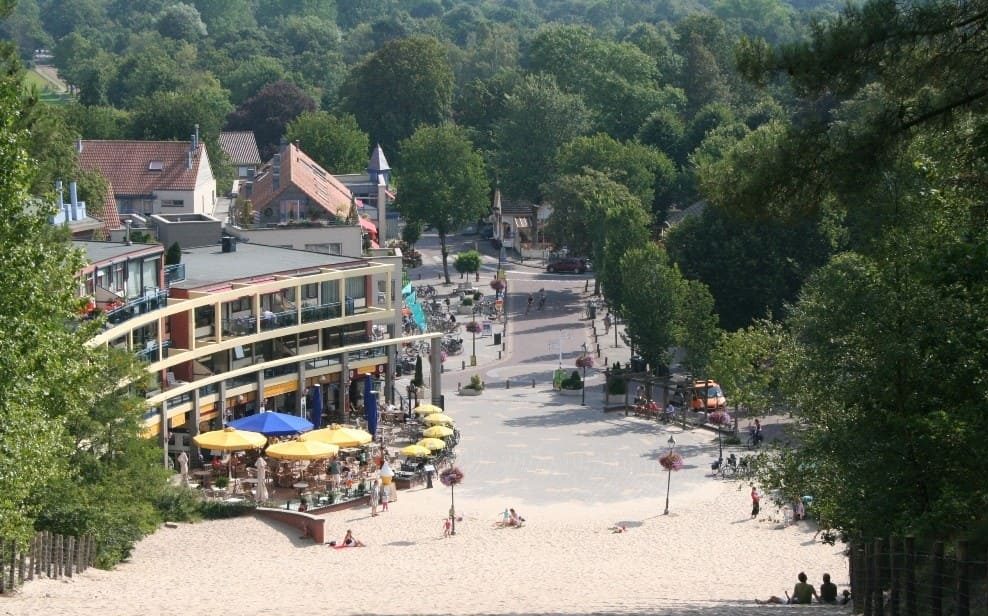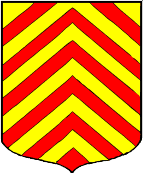Schoorl Dunes
A century ago it was one big sandbox, now a beautiful mix of beach and dunes, forests and heathland.
Climbing in the Schoorl Dunes
Not afraid of a little climbing and descending? Then climb the Schoorl Dunes, Holland’s highest dune area in the north of North Holland and plenty of room to get a breath of fresh air. A century ago this place was one big sandbox; now dozens of bird species breed here, the most beautiful mushrooms grow and the sunlight plays with thousands of tree leaves.
More than 60 kilometers of hiking trail will take you to the highest dunes, the oldest forests or the shifting dunes. Because a hundred years ago, the Forestry Commission allowed the sand to be sequestered precisely by planting trees; now some dunes are allowed to drift freely again. Like at De Kerf where North Sea water has free access to the dune valleys behind during spring tides and northwest storms. With results! The salty sea water allowed plants such as salicornia, sea rocket and salt marsh grass to re-establish themselves here. Following in their wake were birds and dune lizards. Thus, the Schoorl Dunes added another beautiful natural area.
About the Schoorl Dunes
The dunes of Schoorl are a nature lover’s paradise. Open dunes alternate with dense forests and wet plains. Unique are the moors. You can hardly find those anywhere in the dunes. In some places, like De Kerf, the sand is allowed to drift again. New dunes and potholes appear spontaneously. The sand lizard likes to linger in the sand. Those who are lucky will see him sunbathing.
The dunes through the seasons
The Schoorl Dunes are beautiful in all seasons. In winter, when the frost is on the branches, it is enchantingly quiet. In spring, the many birds make their presence felt. Such as the green woodpecker and the very rare nightjar. In June and July, tens of thousands of pine orchids are in bloom. A carpet of tiny white orchids. In August, the heather turns a beautiful purple. And in autumn, over 800 species of mushrooms grow.
The Kerf
De Kerf is the first major exemplary project for “dynamic coastal management,” a new way of managing dunes. In the Netherlands, dune management has traditionally revolved around coastal protection. With shovels, large amounts of sand were dumped into dune valleys and drift pits and then planted with marram grass. Not only did this prove unsuccessful – the coastline slid inland just as much – but in addition, nature and the landscape suffered.
Free play for nature
At the end of the last century, conservationists and dune managers began looking for alternative forms of dune management, with more space for nature. In 1997, measures were taken in the Kerf to restore sand, wind and water. In the process, a hole was also dug in the first row of dunes, allowing seawater to flow into the dune valley behind.
Enrichment of flora and fauna
In recent years, nature has taken advantage of the new situation with lightning speed. Many unusual plants (such as salt torkweed, beach beet and rooted mushroom mushroom) and animals (including the pied-billed plover and natterjack toad) have established themselves in the area. In addition, the interplay of shifting sand and seawater has created a fascinating landscape that countless people enjoy every year. In doing so, De Kerf has become a successful example for other areas.
Collaboration
De Kerf was created thanks to a partnership between the Duinbehoud Foundation, Staatsbosbeheer, Rijkswaterstaat, Hoogheemraadschap Hollands Noorderkwartier and NV PWN Waterleidingbedrijf Noord-Holland. The Forestry Commission, as manager of the area, carried out the work.
Strolling
The Schoorl Dunes has an extensive network of hiking trails. But did you know that a lot of places also allow you to wander and get off the trails? In Jan Bas z’n tuinintje, Speelkuil, Wulpendal, Hargerplas, Groeter and Zandgat you can explore the dunes on your own, in Midden Open Duin you can also follow the struinroute for convenience. Marked hiking trails take you throughout the area, and from there you can start your own wandering route.
Accessibility
Location
Directly north of Bergen.
Size of area
About 1,875 acres.
Opened
The Schoorl Dunes are accessible year-round. In a lot of places, you are allowed off the trails. In Jan Bas z’n tuinintje, Speelkuil, Wulpendal, Hargerplas, Groeter Zandgat you can explore the dunes on your own, in Midden Open Duin you can also follow the wandering route for convenience.
Disabled
The paved bike paths are wheelchair accessible. Guidance is recommended, due to the sometimes steep inclines. Disabled parking is available at the outdoor center. A wheelchair can be borrowed for a deposit (reserve in advance).
Children
Digital animal cards have been hidden near the Soot Road and the
Family Route
. Open the app Perfect Earth Animals when you get to the hiking trail and look for the animal maps! Learn more about the Perfect Earth Animals app here .
Dogs
Dogs are welcome all year round. During the breeding season, from March 1 to September 1, leashed only to avoid disturbance. Outside this period, dogs are allowed off-leash, under roll call. Please note that different rules apply in grazing areas. You can recognize these by the signs.
Hiking map
Hiking map No. 14 Schoorl Dunes is your guide to a journey of discovery through this nature reserve. Mapped routes show you the way, and with the map in your pocket you can also choose your own way. The map can be purchased from Falk’s Web store.
Contact
Staatsbosbeheer Schoorl
Schoorlse Zeeweg 4
1871 PA Schoorl
T 072-5091871

Play Forest
The Play Forest. In the vicinity of Buitencentrum Schoorlse Duinen is Speelduin ‘Het Zandspoor’ of Staatsbosbeheer. Here children can play in nature in abundance and are allowed to go off the trails to explore nature. In the Speelduin there are several places where you can experience all kinds of things: * children can play with a water pump and pump up dune water themselves. * There is a wooden track with sand carts on it like the old days, when that was used to move the sand. * They can climb up 40 meters along a climbing rope and look far over the surrounding area.
Auxiliary Forester Trail
Forester Bas could use some help in the dunes! Are you cut from the right cloth to become an assistant forester. Then come attend the training. Put on your forester’s coat! With a backpack, binoculars, road map and compass, you set out. Forester Bas knows the assignments. Once you complete the training, you will receive an assistant forester’s diploma and a pin. The cost is €5.00 per child. For children ages 7 to 10. Daily walk.
The Nature Cover
Is a hike full of nature discoveries and is designed for the whole family. The card set is suitable for individual, family or group use. Most assignments can be done in any place and in any season. Choose a walk that suits you. During your walk through the Schoorl Dunes, you can use the assignment cards. You determine the length of time. The cost is €10.00 per bag. For the bag you pay a deposit of €10.00. Daily walk.
High Dunes Trail
Especially for children ages 9 to 12, there is the High Dunes Trail from the Forestry Commission. This route is described in an assignment booklet. With fun and active tasks, children experience the dunes.
Barefoot trail
Especially for children ages 9 to 12, there is the High Dunes Trail from the Forestry Commission. This route is described in an assignment booklet.
With fun and active tasks, children experience the dunes.
Gnome Trail
For children ages 4 to 6, at the Forestry Commission’s Speelduin, there is The Gnome Trail “Visiting Gnome Sandpiper in the Schoorl Dunes.”
This walk of about an hour and a half is a discovery tour of the dune.
Opening dates and times
- Sunday 10:00 a.m.-5:00 p.m.
- Monday 10:00 a.m.-5:00 p.m.
- Tuesday 10:00 a.m.-5:00 p.m.
- Wednesday 10:00 a.m.-5:00 p.m.
- Thursday 10:00 a.m.-5:00 p.m.
- Friday 10:00 a.m.-5:00 p.m.
- Saturday 10:00 a.m.-5:00 p.m.









